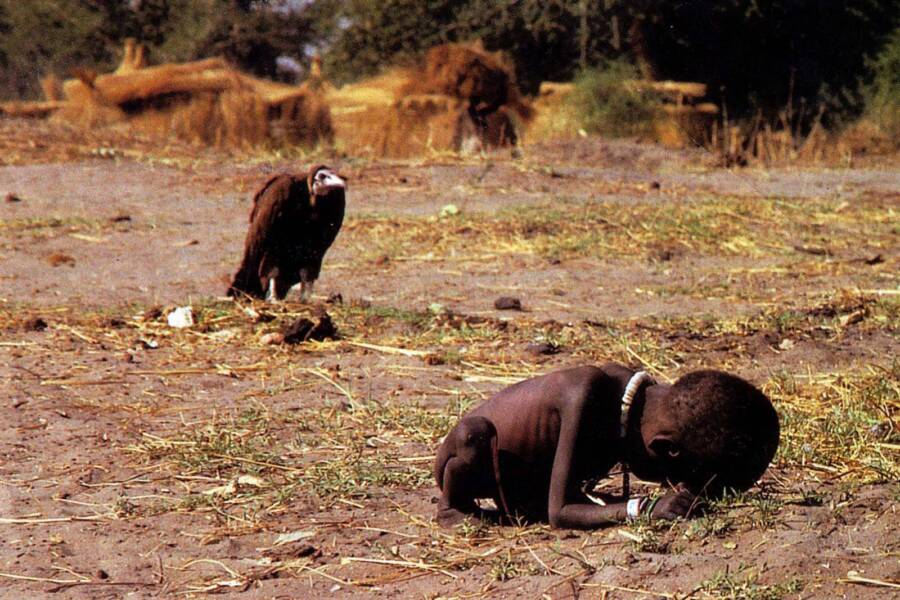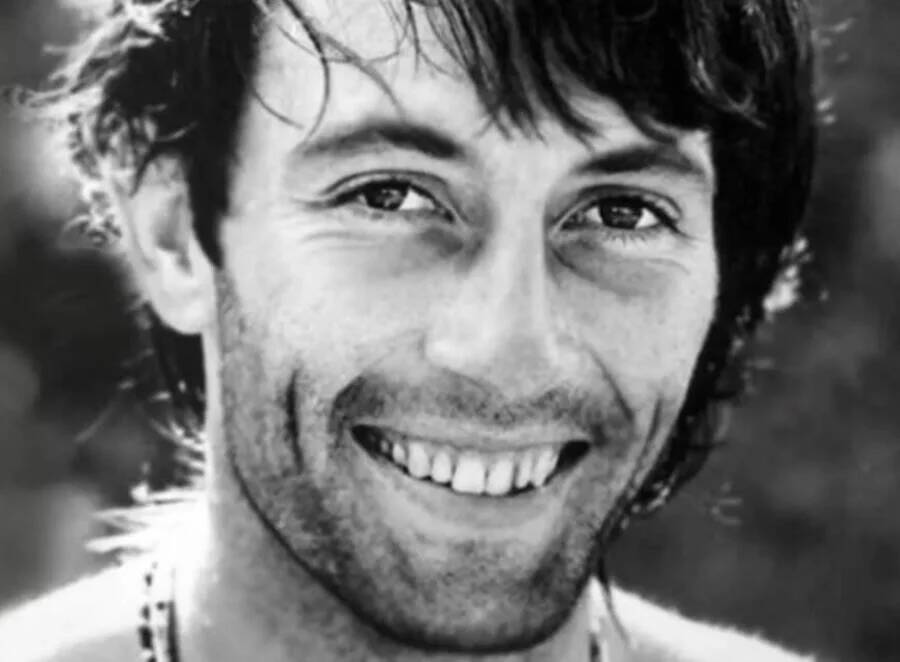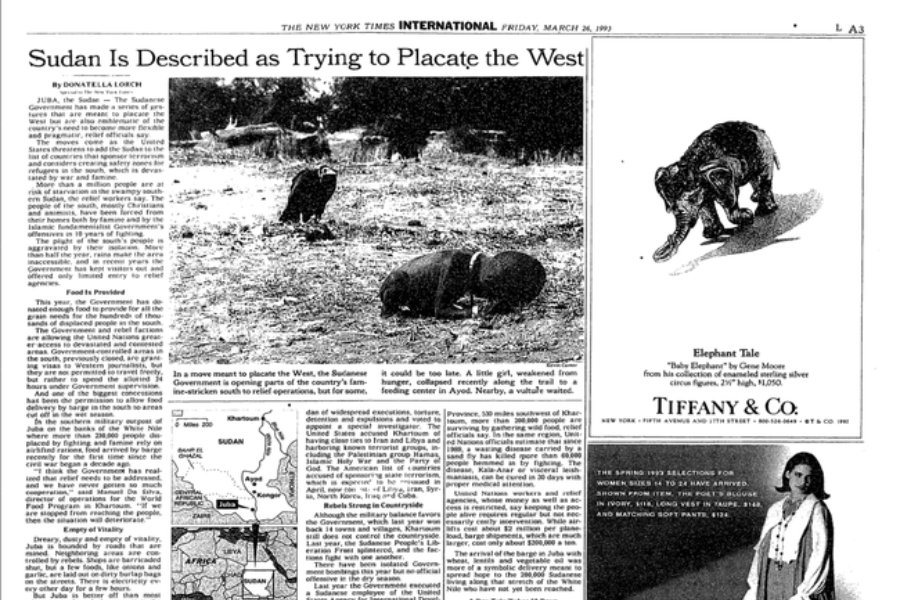A heartbreaking image of a starving Sudanese child trying to reach a feeding center as a vulture watches, "The Vulture And The Little Girl" is one of the most controversial pictures in the history of photojournalism.

Kevin Carter/Wikimedia Commons “The Vulture and the Little Girl,” a 1993 photograph by Kevin Carter, actually depicts a boy named Kong Nyong.
In 1993, South African photojournalist Kevin Carter visited Sudan in the midst of a deadly famine. While there, Carter captured a Pulitzer-winning photograph, “The Vulture and the Little Girl.” However, the experience took a heavy toll on Carter — and eventually drove him to suicide in 1994.
The publication of “The Vulture and the Little Girl” in The New York Times, meanwhile, seemed to attract the attention of the entire world. It was a shocking image that showed the harsh reality of life in Sudan. It also drew many critics, who labeled Carter as inhumane for not intervening and helping the boy in the photograph (incorrectly identified as a girl).
Few knew that Carter had been accompanied by armed Sudanese soldiers who prevented him from interfering with any tragic scenes he witnessed in the country — including the famous one he captured of the emaciated child struggling to reach a feeding center while a vulture looked on.
Days after the photo was published, the Times added an editor’s note informing readers that the vulture had flown away and the child had continued on toward the feeding center. But that’s not the end of the boy’s heartbreaking story, and although Carter’s photograph received much acclaim, it’s clear that he would never be the same after visiting Sudan.
Who Was Kevin Carter?
Kevin Carter was a photojournalist who grew up in South Africa during the apartheid era. Growing up in a whites-only neighborhood, Carter witnessed police raids to remove Black people who had moved into the area illegally.
He was eventually drafted into the army, later enlisting with the Air Force and serving for four years to avoid being put in the infantry. Here, he witnessed more mistreatment of Black citizens. During one instance, Carter saw a Black mess-hall waiter being insulted by white servicemen. He came to the Black man’s defense — and was then beaten by his fellow servicemen.

Wikimedia CommonsKevin Carter, the photojournalist who took “The Vulture and the Little Girl.”
It was after witnessing the 1983 Church Street bombing in Pretoria that Carter made the decision to become a photojournalist and chronicle the horrors of apartheid, joining a group of other photojournalists who were willing to put themselves into dangerous situations to capture the violence of apartheid on camera. The group was dubbed the “Bang-Bang Club.”
Then, in 1993, Kevin Carter was given a special assignment to travel to Sudan and capture photographs of the ongoing famine in the country. It was during that trip that he captured his most famous photograph.
The Cruel Reality Of Sudan’s Famine
In the book The Bang-Bang Club: Snapshots from a Hidden War, authors Joāo Silva and Greg Marinovich — who worked alongside Kevin Carter in the Bang-Bang Club — explain that Carter’s special assignment in Sudan took a heavy toll on the photojournalist, who’d already captured countless devastating and heart-wrenching images throughout his career.
Silva was the one who’d originally been asked by Rob Hadley of the United Nations’ Operation Lifeline Sudan if he would be willing to visit Sudan and chronicle its ongoing famine in 1993. Then, Silva decided to contact Carter about the trip as well, offering him the opportunity to travel there with him.
The general goal of their visit was to capture photos of the humanitarian crisis — which took place amidst civil war and political unrest. They also hoped to help Operation Lifeline Sudan acquire more funding as the true devastation of the famine would be made apparent to the rest of the world.
Silva and Carter indeed traveled to Sudan together, but they went their separate ways after they arrived. They spent days traveling between villages and taking photographs of the starving people of Sudan, meeting up now and then to express their shock and horror at what they were seeing.
“You won’t believe what I’ve just shot!” Carter told Silva shortly before they left the country. “I was shooting this kid on her knees, and then changed my angle, and suddenly there was this vulture right behind her.”
He didn’t know it at the time, but Carter had just captured what would ultimately become one of the most impactful — and controversial — photographs in the entire history of photojournalism.
The Controversy Surrounding “The Vulture And The Little Girl”
On March 26, 1993, The New York Times published Kevin Carter’s photograph, “The Vulture and the Little Girl.” The image was accompanied by the haunting caption: “A little girl, weakened from hunger, collapsed recently along the trail to a feeding center in Ayod. Nearby, a vulture waited.”
Almost immediately, the Times’ readers began writing in, inquiring about what happened to the child after the photograph was taken.

The New York Times Archives“The Vulture and the Little Girl” as it appeared in The New York Times on March 26, 1993.
Fortunately and unfortunately for Carter, the photograph resonated with the public. Times readers were heartbroken by the image, concerned for the well-being of starving children in Sudan, and angry that Carter, the photographer, would take the time to focus his lens and frame the snapshot when he could have, they argued, helped the child instead.
Of course, most people were unaware that Carter and his fellow photojournalists had been accompanied by armed soldiers who were there specifically to stop them from interfering with any horrific scenes in front of them. Still, readers were furious to learn that Carter didn’t even stick around to find out what had happened to the child — and he wasn’t sure whether the starvation victim had ever reached the feeding center.
Despite the widespread controversy, Carter won a Pulitzer Prize for the photograph in 1994 and he was widely credited with revealing the plight of the Sudanese people to the world. But he died by suicide later that same year, apparently haunted by the horrors that he’d witnessed in the country.
Meanwhile, the fate of the child remained a mystery until 2011.
What Happened To The Child From “The Vulture And The Little Girl”?
In 2011, reporters from the Spanish newspaper El Mundo traveled to Sudan to try and find the child featured in Kevin Carter’s famous photograph. While they did not find the child, they did find the child’s father.
The father revealed that the “little girl” in the photo was actually a young boy named Kong Nyong. Amazingly, Nyong’s father said that the boy had survived the 1993 famine and had somehow managed to make it to the feeding center the day he was photographed. But alas, his life was still cut short.
According to Nyong’s family, he died tragically young of “fevers” in 2007, having contracted some unidentified disease.
Ultimately, both Kong Nyong and Kevin Carter are forever immortalized by the photograph “The Vulture and the Little Girl.” And even though the picture led to Carter being heavily criticized, it still stands as one of the most striking examples of photojournalism, with two symbols — the vulture and Nyong — perfectly encapsulating the plight of Sudan during the famine, and the turbulent political circumstances surrounding it.
After learning about “The Vulture and the Little Girl,” read about the true story behind the famous “Migrant Mother” photograph. Then, discover the sad story behind another well-known photograph, “4 Children For Sale.”





